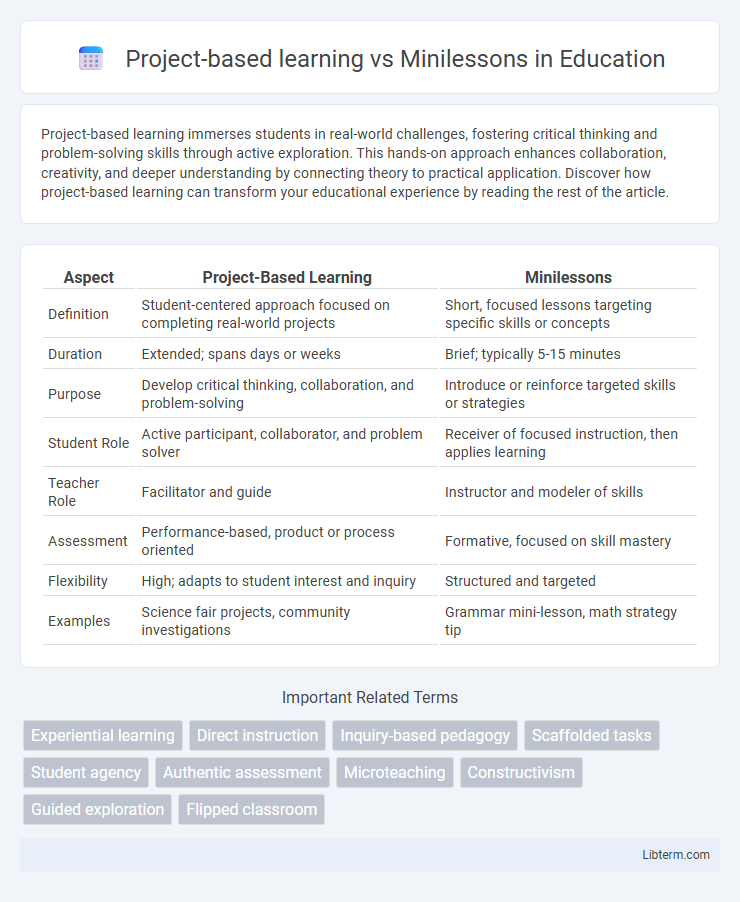Project-based learning immerses students in real-world challenges, fostering critical thinking and problem-solving skills through active exploration. This hands-on approach enhances collaboration, creativity, and deeper understanding by connecting theory to practical application. Discover how project-based learning can transform your educational experience by reading the rest of the article.
Table of Comparison
| Aspect | Project-Based Learning | Minilessons |
|---|---|---|
| Definition | Student-centered approach focused on completing real-world projects | Short, focused lessons targeting specific skills or concepts |
| Duration | Extended; spans days or weeks | Brief; typically 5-15 minutes |
| Purpose | Develop critical thinking, collaboration, and problem-solving | Introduce or reinforce targeted skills or strategies |
| Student Role | Active participant, collaborator, and problem solver | Receiver of focused instruction, then applies learning |
| Teacher Role | Facilitator and guide | Instructor and modeler of skills |
| Assessment | Performance-based, product or process oriented | Formative, focused on skill mastery |
| Flexibility | High; adapts to student interest and inquiry | Structured and targeted |
| Examples | Science fair projects, community investigations | Grammar mini-lesson, math strategy tip |
Introduction to Project-Based Learning and Minilessons
Project-based learning (PBL) immerses students in complex, real-world projects that promote critical thinking and problem-solving over extended periods. Minilessons offer concise, targeted instruction focused on specific skills or concepts, typically lasting 10-15 minutes to provide immediate, actionable learning. PBL supports deep engagement and collaborative exploration, while minilessons deliver focused skill-building that can be integrated within larger learning experiences.
Defining Project-Based Learning: Key Characteristics
Project-based learning is an instructional approach that engages students in exploring real-world problems through extended, student-centered projects, promoting collaboration, critical thinking, and authentic assessment. Key characteristics include inquiry-driven tasks, interdisciplinary content, sustained inquiry over weeks or months, and student autonomy in decision-making. Unlike minilessons, which are brief, focused instructional sessions targeting specific skills or concepts, project-based learning emphasizes holistic, active learning experiences with tangible outcomes.
Understanding Minilessons: Essential Features
Minilessons are concise instructional segments typically lasting 10 to 15 minutes, designed to target specific skills or concepts within a larger project-based learning framework. These focused lessons emphasize direct instruction, modeling, and guided practice, helping students build foundational knowledge before engaging in independent or collaborative project work. Essential features include clear learning objectives, active student participation, and immediate application of skills to ensure deep comprehension and retention.
Core Differences Between Project-Based Learning and Minilessons
Project-based learning emphasizes extended, student-driven exploration of real-world problems, fostering critical thinking, collaboration, and application of knowledge over time. Minilessons center on brief, focused instruction targeting specific skills or concepts, designed for immediate practice and reinforcement within a shorter time frame. The core difference lies in project-based learning's immersive, comprehensive approach versus minilessons' concise, skill-specific delivery.
Benefits of Project-Based Learning in the Classroom
Project-based learning (PBL) enhances student engagement by fostering real-world problem-solving skills and collaboration, leading to deeper understanding and retention of subject matter. It promotes critical thinking, creativity, and autonomy, as students take ownership of their learning through hands-on projects that connect with their interests and community. Research indicates that PBL improves academic outcomes and social-emotional skills compared to traditional minilessons, making it a powerful approach for holistic classroom development.
Advantages of Minilessons for Targeted Instruction
Minilessons offer targeted instruction by delivering concise, focused content that addresses specific student needs, enabling quick skill acquisition and immediate application. Their brief format allows educators to tailor lessons to individual or small group learning gaps, fostering deeper comprehension and retention. This approach enhances classroom efficiency by minimizing downtime and maximizing instructional impact on critical concepts.
Challenges and Limitations: PBL vs Minilessons
Project-based learning (PBL) often faces challenges such as extended time requirements, difficulty in aligning projects with standardized curricula, and uneven student participation, which can impact learning outcomes. Minilessons, while offering targeted, concise instruction, may limit opportunities for deep exploration and hands-on application, potentially reducing student engagement. Both approaches require careful balancing to address time constraints, diverse learning needs, and assessment complexities.
Effective Contexts for Project-Based Learning
Project-based learning (PBL) thrives in contexts requiring deep exploration of complex, real-world problems where student collaboration and critical thinking drive knowledge construction. Minilessons are more effective for targeted skill acquisition and immediate application within a structured timeframe, providing concise, focused instruction. PBL is particularly beneficial in interdisciplinary settings and long-term projects that cultivate problem-solving and intrinsic motivation.
When to Use Minilessons for Maximum Impact
Minilessons are most effective when addressing specific skill gaps or introducing targeted concepts within a larger project-based learning framework. Use minilessons to provide concise, focused instruction that supports student autonomy and fosters immediate application of knowledge. Implementing minilessons at strategic intervals helps maintain engagement and ensures mastery before progressing to complex project tasks.
Integrating Project-Based Learning and Minilessons for Optimal Results
Integrating project-based learning and minilessons enhances student engagement by combining hands-on exploration with targeted skill development, promoting deeper understanding and retention. Minilessons provide concise, focused instruction on specific concepts or techniques directly applicable to ongoing projects, ensuring students acquire essential knowledge without losing momentum. This balanced approach fosters critical thinking, creativity, and personalized learning pathways, maximizing educational outcomes across diverse learner profiles.
Project-based learning Infographic

 libterm.com
libterm.com